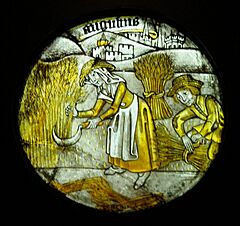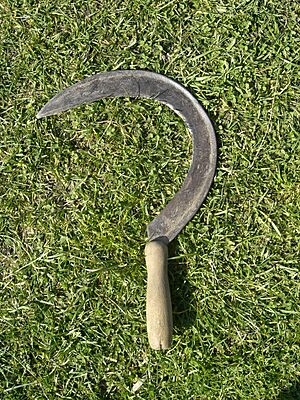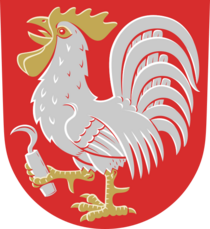Sickle facts for kids

Nepalese sickle from Panchkhal
|
|
| Other names | Bagging hook, reaping-hook |
|---|---|
| Classification | Cutting |
| Related | Scythe |
A sickle, bagging hook, reaping-hook or grasshook is a single-handed agricultural tool designed with variously curved blades and typically used for harvesting or reaping grain crops, or cutting succulent forage chiefly for feeding livestock. Falx was a synonym, but was later used to mean any of a number of tools that had a curved blade that was sharp on the inside edge.
Since the beginning of the Iron Age hundreds of region-specific variants of the sickle have evolved, initially of iron and later steel. This great diversity of sickle types across many cultures can be divided into smooth or serrated blades, both of which can be used for cutting either green grass or mature cereals using slightly different techniques. The serrated blade that originated in prehistoric sickles still dominates in the reaping of grain and is even found in modern grain-harvesting machines and in some kitchen knives.
Use
The inside of the blade's curve is sharp, so that the user can either draw or swing it against the base of the crop, catching the stems in the curve and slicing them at the same time. The material to be cut may be held in a bunch in the other hand (for example when reaping), held in place by a wooden stick, or left free. When held in a bunch, the sickle action is typically towards the user (left to right for a right-handed user), but when used free the sickle is usually swung the opposite way. Other colloquial/regional names for principally the same tool are: grasshook, swap hook, rip-hook, slash-hook, reaping hook, brishing hook or bagging hook.
A serrated sickle was used for harvesting wheat, the ears being held bunched up in the free hand as described above. After this the straw was cut with a scythe. Oats and barley on the other hand were simply scythed. The reason for this is that wheat straw, unlike that of oats or barley, whose softer straw was suitable only for bedding or fodder, was a valuable crop, used for thatching, and subjecting it to the battering of a flail would have rendered it useless for this purpose.
The blades of sickle models intended primarily for the cutting of grass are sometimes "cranked", meaning they are off-set downwards from the handle, which makes it easier to keep the blade closer to the ground. Sickles used for reaping do not benefit by this feature because cereals are usually not cut as close to the ground surface. Instead, what distinguishes this latter group is their often (though not always) serrated edges.
A blade which is used regularly to cut the silica-rich stems of cereal crops acquires a characteristic sickle-gloss, or wear pattern.
As a weapon
Like other farming tools, the sickle can be used as an improvised bladed weapon. Examples include the Japanese kusarigama and kama, the Chinese chicken sickles, and the makraka of the Zande people of north central Africa. Paulus Hector Mair, the author of a German Renaissance combat manual also has a chapter about fighting with sickles. It is particularly prevalent in the martial arts of Malaysia, Indonesia and the Philippines. In Indonesia, the native sickle known as celurit or clurit is commonly associated with the Madurese people, used for both fighting and as a domestic tool.
Other uses
- The hammer and sickle is a communist symbol representing proletarian solidarity, a union between the peasantry and the urban working class. It was first adapted during the Russian Revolution, the hammer representing the industrial workers, and the sickle representing the farmers/peasants.
- The emblem of the Grim Reaper, who is sometimes portrayed as carrying a sickle rather than the more traditional scythe.
- Tacitus reports that golden sickles were used in Druidic rituals.
- Paulus Hector Mair's Manuscript Dresd. C 93 includes a section regarding the martial application of the sickle.
- Three (or two) entwined sickles were the heraldic badge of the medieval Hungerford family. See also Hungerford knot.
Bagging hook
A bagging hook, badging hook, fagging hook, reap hook or rip hook, is a large sickle usually with an offset handle so that the user's knuckles do not make contact with the ground. The Oxford dictionary gives the definition of the word to bag, or badge, as the cutting of grain by hand. The blade is heavier than that of a normal sickle and always without serrated blades. It is usually about 40 mm (1.6 in) wide with an open crescent shaped blade approx 45 cm (18 in) across. It developed from the sickle in most parts of Britain during the mid to late 19th century, and was in turn replaced by the scythe, later by the reaping machine and subsequently the swather. It was still used when the corn was bent over or flattened and the mechanical reaper was unable to cut without causing the grain to fall from the ears and wasting the crop.
It was also used in lieu of the bean hook or pea hook for cutting field beans and other leguminous crops that were used for fodder and bedding for livestock.
Sometimes confused with the heavier and straighter billhook used for cutting wood or laying hedges. While the scythe or bagging hook blade was heavy enough to remove young growth instead of, say, shears for clipping a hedge, it was not strong enough to cut woody material for which the stronger, similarly shaped, but longer handled, staff hook was used. Many variations in blade shape were used in different parts of England and known under a variety of names. Its close relations in shape and usage are the grass hook and the reap hook.
Images for kids
-
A very early sickle, c. 7000 BC, flint and resin, Tahunian culture, Nahal Hemar cave, now in the Israel Museum.
-
Ancient Greek iron sickle, Kerameikos Archaeological Museum, Athens.
-
Congolese sickle, or Trumbash, (left) and replica throwing knife (right) at Manchester Museum
See also
 In Spanish: Hoz (herramienta) para niños
In Spanish: Hoz (herramienta) para niños
- Aruval, an Indian instrument similar to the billhook
- Billhook, a version of the sickle used for cutting woody stems
- Brush hook
- Kaiser blade or sling blade
- Kama
- Machete
- Scythe
- Hammer and sickle, a symbol in communism
- Harpe, a Greek or Roman long sickle or scythe
- Khopesh, an Egyptian long sickle or scythe as a weapon









